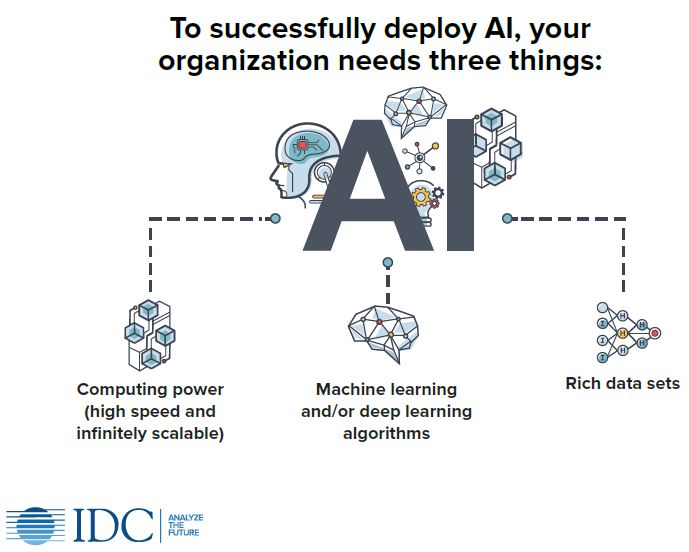For companies that are committed to creating Digital Transformation (DX) within their organizations, artificial intelligence (AI) is a critical component. The data that is created in DX initiatives has limited value if an organization can’t extract valuable, accurate, and timely insights from it. That’s why enterprise organizations are using AI technologies to pull actionable value from its data; in fact, by the end of 2019, 40% of all DX initiatives will be related to AI.
While AI is critically important to DX and to business success, companies are implementing AI haphazardly, without understanding where or how to implement it to maximize its effectiveness. How do you prioritize where to implement AI technologies and how to use AI most efficiently? The answer is to create an organization-wide Artificial Intelligence Strategy that prioritizes the business’s goals and iterates where AI technology can be used to achieve those goals more quickly or completely.
When creating an AI strategy, remember to keep the following in mind:
Focus on Strategic Business Goals
A common mistake that organizations make when thinking about AI is to align their AI efforts with a technology goal, as opposed to a strategic business goal. To create sustainable, organization-wide success, think about the large-scale goals your organization is pursuing, such as improving profit or reducing workforce costs, and investigate where and how AI technology can help achieve those goals. AI at its core offers acceleration, accuracy, and automation, so consider where these benefits will make the biggest difference with regards to achieving your organization’s long-term goals.
Aim for Disruption with New, AI-Enabled Business Models
The whole point of building an AI strategy is to create sustainable competitive advantage through DX. One way to do that is to take advantage of disruptive business models when possible to differentiate and create that leverage. Here’s a useful exercise to help discover areas where disruption can be useful: visualize a business model where the company would cease to exist without a foundation in artificial intelligence.
For example, take the car insurance industry. The insurance premium is proportional to the risk taken on by the company; if your car is parked in a high-risk neighborhood, the premium will be higher. A company could create an offering that uses AI to digest big data collected from credit agencies, crime reporting agencies, weather companies, people data, and other sources and compute a risk score for the car so that the insurance company can offer an accurate premium. That company would be disruptive to the insurance industry, as companies that use it can offer more accurate rates and better customer service based upon the disruptive nature of that computation. Without AI’s ability to quickly and accurately collect and parse all that data and then compute an accurate risk score, that company would not exist.

Now, realize that this type of business model doesn’t just exist at the company level; these disruptions can exist at the department or line-of-business level of an organization. These are the areas in your organization where, when aligned with your business goals, a sustainable competitive advantage based on AI can be implemented.
Leverage the Right People to Execute Your AI Strategy
You don’t need to build a full-fledged AI team to start with, unless your primary business is AI, but you will need buy-in and expertise from the right people to get your strategy off the ground. You’ll need to address both the business and technology sides of your AI strategy; find business people who have a general understanding of AI and people who can understand and work with data and programmers. You will need business architects who can transition smoothly between business and technology and are skilled communicators.
You will need a couple of data architects and data scientists who can architect, build and train on models, as well as a few application developers who can integrate algorithms to your existing applications or build new AI applications, even though you might use Cloud services like IBM Watson, AWS AI/ML Services, Microsoft Azure Cognitive Services or Google Cloud AI in the early stages of your AI journey.
Additionally, you will need a strategist who can apply AI to the business effectively. Having the right people in place will help you accelerate your AI strategy execution and ensure you are leveraging AI in the right places to achieve your goals. In the long term, you can build and expand the team and associated skill sets if it makes sense to based upon your organization’s decision to build, buy or customize your solution or use embedded AI.
Artificial intelligence has been pushed to the top of the corporate agenda. As it accelerates into the mainstream, organizations will need to have an effective AI strategy aligned with business goals and innovative business models to thrive in the digital era.
Learn what foundational elements your AI strategy needs; download IDC’s new eBook, “The Four Elements Your AI Strategy Needs to Succeed”.




